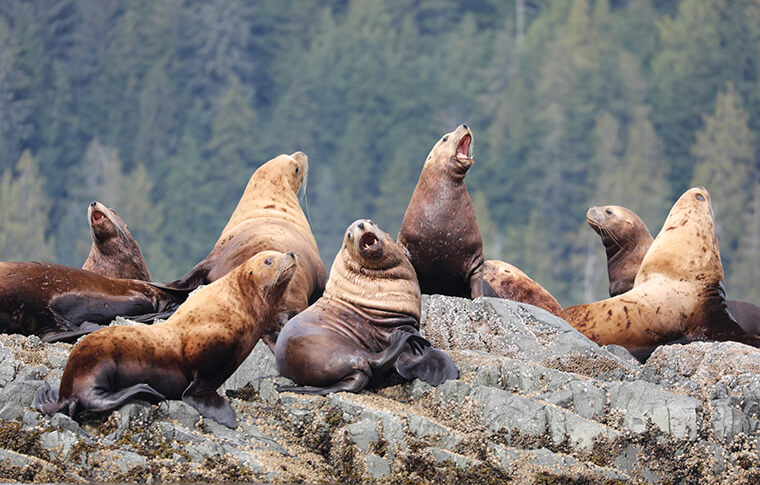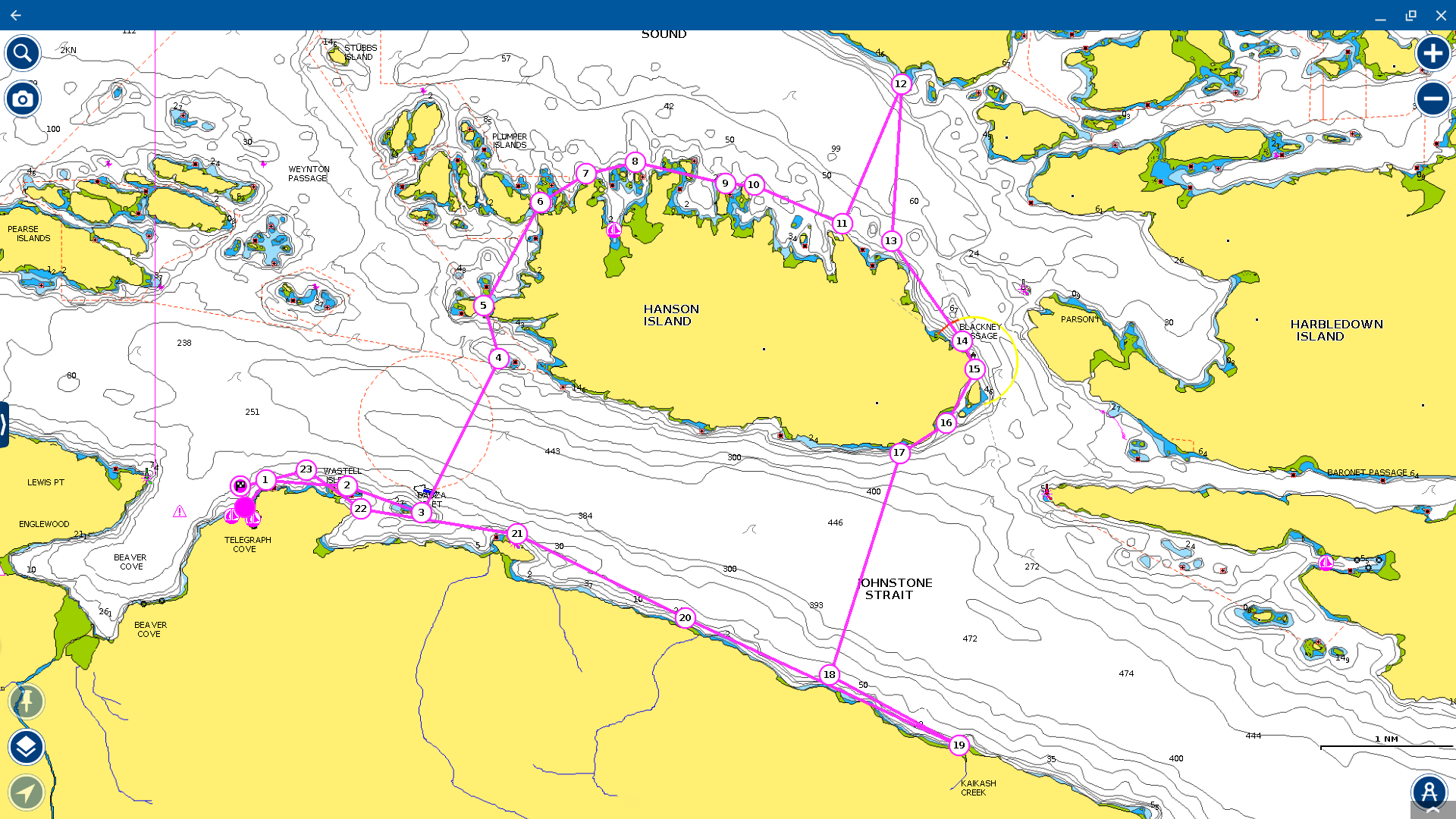Self-Guided Weekend Itineraries For Kayaking Johnstone Strait

For experienced kayakers who have only the weekend or a few days, a 3-day self-guided kayaking tour of Johnstone Strait will give you a good taste of the area. Departing from Telegraph Cove, where kayak rentals are available, you’ll have the chance to see some of the spectacular wildlife that draws paddlers from around the planet each year to kayak with whales. With two nights and three days, we suggest making a trip across the Strait and around Hanson Island. Here are two variations that take in slightly different routes and sights.
Itinerary 1
Day 1: Telegraph Cove to Flower Island (9 nautical miles)
From Telegraph Cove, paddle east towards Bauza Inlet, crossing Johnstone Strait from Bauza and continue north towards Turn Point. Once on Hanson Island, a great place for lunch or a break, is Leg Cove, which is located inside the Plumper Group, a network of rocky islands and islets bordering Weynton Passage and known for strong currents and as a habitat for rich invertebrate life. The Plumper Islands are part of Cormorant Channel Marine Park, which is also home to several rare bird species such as the marbled murrelet, rhinoceros auklet and albatross.
Marine mammals such as harbor seals, Steller sea lions and humpback whales can often be found feeding off the strong currents of Weynton Passage. This passage produces some of the highest current speeds in the area and should not be undertaken lightly. Be sure to have your tides and current calculations completed before you go and time your northern passage through the Plumper’s on a slack tide, turning to ebb.

Next you’ll pass through the Blowhole, then turn east along Hanson Island, taking in the colourful intertidal marine life along Hanson’s north shore. Just before reaching Burnt Point, cross Blackfish Sound to tiny Flower Island.
The campsite at Flower Island has a sand and pebble beach, so landing here is relatively easy. Set up your kitchen and tents in the forest and your latrine in the intertidal zone. (Be sure to follow marine Leave No Trace procedures to keep campsites clean for the next group). The forest is hammock-friendly and once you’ve set up camp and are comfortable, walk to the southwest point of Flower Island for great views over Blackfish Sound and to spot orcas, humpbacks and pacific whitesided dolphins.
Hazards: Be aware of vessel traffic in Johnstone Strait and Blackfish Sound and strong currents in the Blowhole. Use tide tables to plan your trip through the Blowhole for slack tide.

Day 2: Flower Island to Kaikash Creek (7 nautical miles)
Cross Blackfish Sound from Flower Island to Burnt Point on Hanson Island, continue along Hanson’s southeast coast towards Licka point and Blackney Pass until you reach the southeast tip of Hanson. This is where you’ll see Orca Lab, a killer whale research station started in 1970, by Dr. Paul Spong, which uses hydrophones for low-impact studies of orcas. From there take a due south bearing across Johnstone Strait towards Kaikash Creek. Plan to have lunch at Little Hanson Island or at Kaikash. Paddling to Kaikash from Flower Island should not take too long, so a great side trip is paddling out to the Robson Bight (Michael Bigg) Ecological Reserve’s border if you have time. This is Canada’s only marine sanctuary for killer whales and comprises 9kms of Johnstone Strait’s coastline and the surrounding forest. It features a pebble beach which orcas use for rubbing. The area is marked as off-limits, so do not enter, but you may see orcas passing by on their way in or out.
The landing at Kaikash Creek is a rocky beach, which is very slippery at low tide. Set up your kitchen and campsite in the forest. This site can be popular, so spend some time finding a nice place to camp further in the forest if you want privacy. Fresh water can be obtained from Kaikash Creek but should be treated before drinking. An outhouse is available here.
Hazards: 5+kts current at Blackney Passage/Licka point requires travel through only at slack, arriving 30 minutes early. At Kaikash, be bear aware and store food in kayak hatches or bear caches.

Day 3: Kaikash Creek to Telegraph Cove (7 nautical miles)
You’re already on Vancouver Island, so simply paddle west hugging the shoreline, stopping at Blinkhorn Peninsula for lunch and a hike to a nice viewpoint if time allows. This stretch of coastline has fantastic intertidal life at low tide, so exploring tide pools or beach combing can be a great activity as well. The kelp beds are dense here, so be on the lookout for harbour seals and sea lions which often patrol these rich habitats in search of food. Eventually you’ll reach Telegraph Cove, back where your trip began.
Itinerary 2
Day 1: Telegraph Cove to Kaikash Creek (7 nautical miles)
Paddle east from Telegraph Cove, travelling through the Wastell Islets, a beautiful intertidal area home to rich invertebrate life. Continue along Vancouver Island keeping an eye out for orcas, humpbacks and pacific whitesided dolphins. Plan to visit the border of the Robson Bight Ecological Reserve and campo at Kaikash Creek, as above.
Day 2: Kaikash Creek to Pool Point (8 nautical miles)
Cross over to Hanson Island aiming for its southeast point. Go through Kingfisher Pass, keeping along Hanson Island until you reach the northwest tip of the island. Here you’ll find the two entrances to Double Bay, hence its name.
On this part of Hanson island, you’ll see Orca Lab and also spot many rusting relics of the bygone logging industry in the forest. The haul-out for the campsite at Pool Point is rocky and very slippery at low tide. Set up your campsite in the forest, but be aware that space is limited. Latrine is the intertidal zone. There is no freshwater here, so make sure to bring enough.
The west side of Hanson has great sunsets and Double Bay is a safe, protected spot for a night paddle, to experience the magical glow of phosphorescence as your kayak shimmers with each paddle stroke.

Day 3: Pool Point to Telegraph Cove (5.5 nautical miles)
After leaving camp at Pool Point, Head south through the Blowhole (Plumper Islands) towards Weynton Island. From Weynton, paddle towards Turn Point for a lunch break. Then cross Johnstone Strait to Blinkhorn Peninsula and continue west to Telegraph Cove.
Need help with planning your own self-guided kayaking tour? Click here for more information on our outfitting services and training courses
Additional Resources

